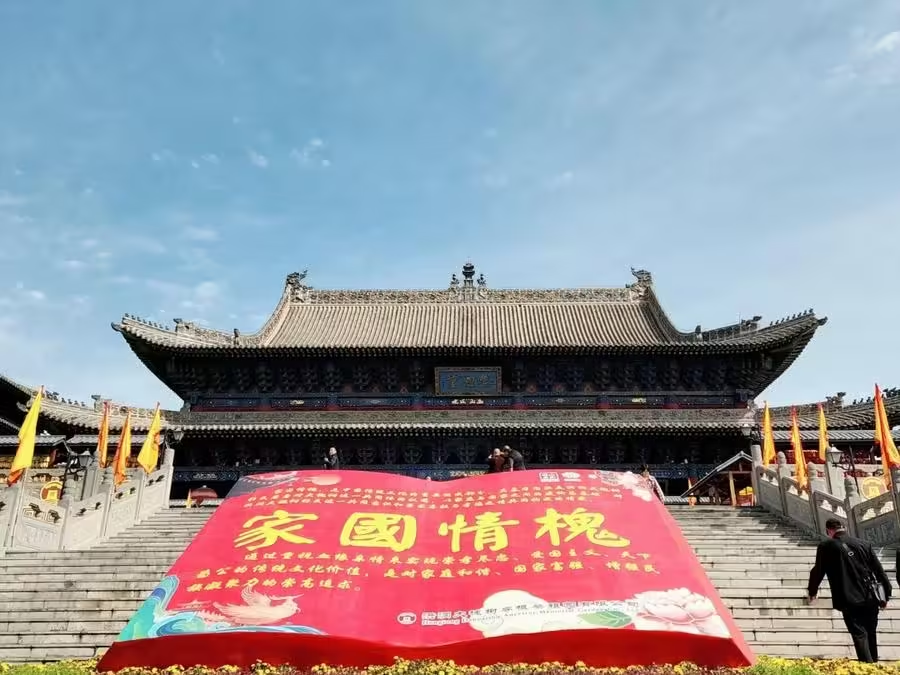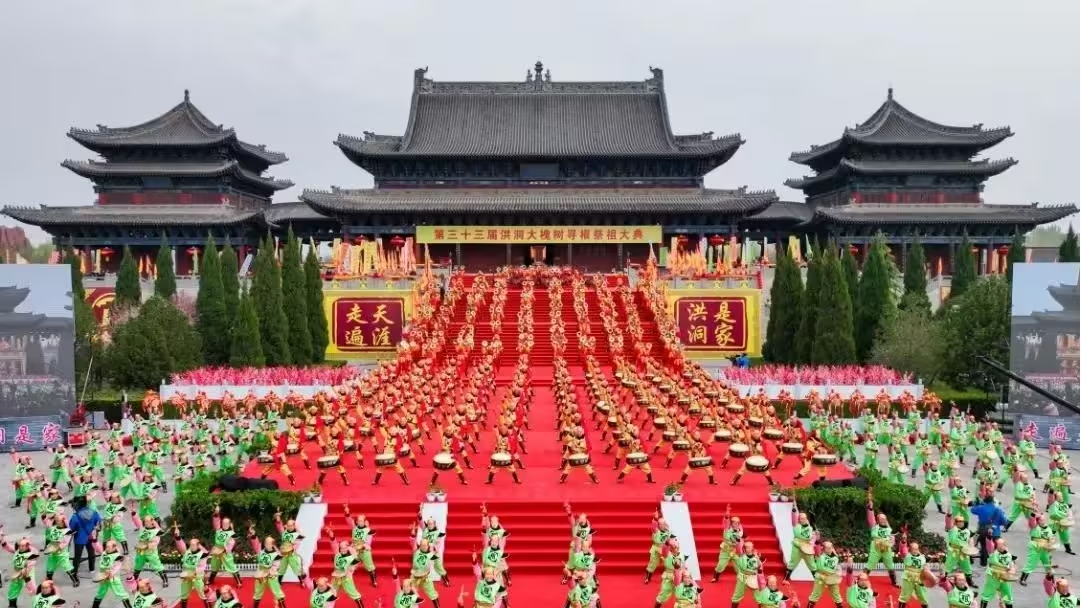Hongtong Dahuaishu Ancestor Memorial Garden (洪洞大槐树寻根祭祖园) is the only national site in China dedicated to the themes of “root-seeking” and “ancestor worship.” The park is divided into five thematic areas: the “Ancient Immigration Site Area,” the “Ancestor Worship Area,” the “Folk Culture Area,” the “Fenhe River Ecological Area,” and the “Root and Ancestor Culture Square.” The garden features over 60 cultural and scenic sites, including the Beiting Pavilion, the second and third generation Dahuaishu (Big Pagoda Trees), the Millennium Pagoda Tree Root, the Ancestor Worship Hall, Guangji Temple, the Stone Sutra Pillar, the Immigration Relief Sculpture, and the Chinese Surname Garden.
The migration associated with the Hongtong Dahuaishu began during the late Northern Song Dynasty when the imperial family moved south and continued through the Ming Dynasty under Emperors Hongwu and Yongle, reaching its peak, and extending into the mid-Qing Dynasty. This migration spanned more than 700 years, from 1101 during the reign of Emperor Huizong of the Song Dynasty to 1820 in the 25th year of Emperor Jiaqing’s reign in the Qing Dynasty. The large-scale migration during the Ming Dynasty under Emperor Hongwu and Yongle was the largest, most widespread, and most organized migration in Chinese history. Initiated by Emperor Zhu Yuanzhang, the migration aimed to strengthen the economic foundation of the Ming Dynasty through agricultural colonization. The migration, which lasted 50 years, involved 1,230 surnames, with millions of descendants spreading across China.
Table of Contents
- Basic Information
- Location and Transportation
- Highlights of Hongtong Dahuaishu Ancestor Memorial Garden
- Vlog about the Memorial Garden
- Other Attractions in Linfen City
Basic Information
| Estimated Length of Tour | 2 hours |
| Ticket Price | 80 RMB |
| Opening Hours | 8.00 – 19.00 (1st April – 31st October) 8.30 – 17.30 (31st March – 1st November) |
| Telephone Number | 0086-0357-6658066 0086-0357-6658081 |
Location and Transportation
The Hongtong Dahuaishu Ancestor Memorial Garden is located at No. 002, Guhuai North Road, Gongyuan Street, Hongtong County, Linfen City, Shanxi Province. After arriving at Hongtong West Station or Hongtong Station by high-speed rail or train, you can take a bus to the Hongtong Dahuaishu Scenic Area. From Hongtong West Station, take Bus 26 to the Heating Company stop, then transfer to Bus 5 and get off at Dahuaishu Park. Alternatively, from Hongtong Station, walk 600 meters to the Tax Bureau bus stop and take Bus 3 directly to Dahuaishu Park.
Highlights of Hongtong Dahuaishu Ancestor Memorial Garden
Root Sculpture Gate

The “Root Sculpture Gate” serves as the main entrance to the Hongtong Dahuaishu Ancestor Memorial Garden. Shaped like the roots of a pagoda tree, this gate spans 20 meters in width and stands 13 meters tall. Its design is ancient and majestic, with thick, powerful roots symbolically anchoring into the earth. This gate embodies the unity of the descendants of the Dahuaishu tree—sharing the same lineage, roots, ancestors, and spirit. It represents the children of the Dahuaishu who, sacrificing personal comforts for greater causes, have rooted themselves deeply in China, tirelessly working and striving for the nation’s prosperity and the flourishing of the Chinese people. The gate symbolizes the shared roots, the shared homeland, and the collective soul of the Dahuaishu descendants.
Root Character Screen Wall

The “Root Character Screen Wall” is a signature feature of the park. The large “根 Root” character, written in a vigorous and stable style, was created by Zhang Ding, the former president of the China Academy of Arts and a renowned calligrapher and painter. The character is bold and dignified, with a hidden pictographic element, carrying deep meaning. It reflects a profound sense of connection to one’s homeland and a deep yearning for one’s roots, encapsulating the complex emotions of homeland and nation that reside in the hearts of those returning to their ancestral land.
Stele Pavilion (Ancient Dahuaishu Site)

The Stele Pavilion is built on the site of the first generation of the Dahuaishu tree. The stele stands at a height of 3.15 meters and is over 0.73 meters wide. The top of the stele is adorned with intricate carvings of coiled dragons, with the word “Memorial” inscribed in seal script. The front of the stele bears the five large characters “古大槐树处” (“Site of the Ancient Dahuaishu Tree”) in clerical script. Interestingly, these characters were not written with a traditional pen but were brushed on. One of the site’s restorers, Liu Zilin, had a friend who was very poor and could not afford to donate money for the construction of the pavilion. Instead, he contributed by brushing these characters, which were so well-done that they were adopted for the stele, despite his modest means.
Second and Third Generation Dahuaishu Trees

The second-generation Dahuaishu tree, which grew from the roots of the original tree, is nearly 400 years old. The third-generation tree, which also sprouted from the same roots, is almost a century old. When the emigrants of old bid farewell to their homeland, they saw the Dahuaishu tree as a symbol of their native place. Upon settling in new lands, they would often plant a locust tree in their courtyards and hang a talisman as a way to seek the blessings of their ancestral home and express their longing for it.
Ancestor Worship Hall

The Ancestor Worship Hall, designed and constructed by the Shanxi Ancient Architecture Protection Institute, is the core of the Hongtong Dahuaishu Ancestor Memorial Garden. This hall, modeled after Ming Dynasty architecture, faces south and has a width of 112 meters and a depth of 55 meters, covering a total area of 6,160 square meters. In front of the hall stands an open-air bronze tripod incense burner, while inside, there are 1,230 ancestral name plaques of immigrants, reflecting traditional culture and emphasizing the theme of ancestor worship. It is the largest ancestral hall dedicated to the hundreds of surnames in China, known as the foremost hall for public ancestor worship in the nation.
Offering Hall

The Offering Hall is where offerings are placed during worship ceremonies and serves as the primary activity area for officiants. Positioned along the central axis of the worship area, this hall covers 1,250 square meters, with five bays in both width and depth. It features a single-story double-eave design, with verandas surrounding all sides. Constructed entirely of wood in the Ming Dynasty style, the hall is topped with a cross-gabled roof that connects seamlessly with a replica Ming-style stage. Its height and span are unmatched in Shanxi, and its grandeur is rarely seen across the country.
Stone Sutra Pillar

The Stone Sutra Pillar is the oldest artifact in the memorial garden and the only remaining historical evidence of the Ming Dynasty migration. Originally a type of Buddhist stone carving that began during the Tang Dynasty, this pillar was constructed in 1201 by Master Huilian of Guangji Temple, predating the migration by over 200 years. It is the sole remaining relic of Guangji Temple and a quintessential example of a sutra pillar, standing over 800 years old. Made of bluestone, the pillar has an octagonal base and rises to a height of 9.4 meters, with four tiers and fifteen segments. The carvings on the pillar are ancient and profound, with calligraphy that is both powerful and fluid, and the reliefs are vividly lifelike, making it a treasured example of Jin Dynasty stone carving art.








